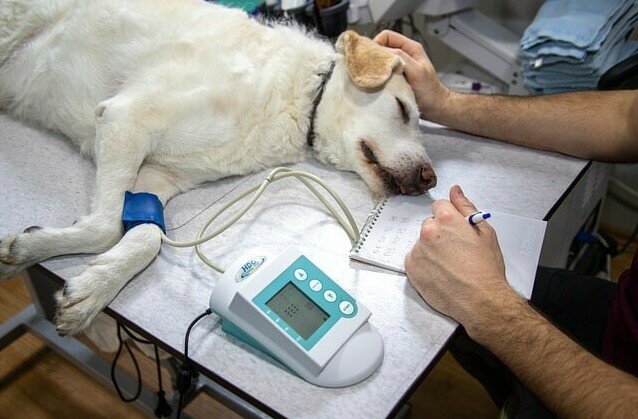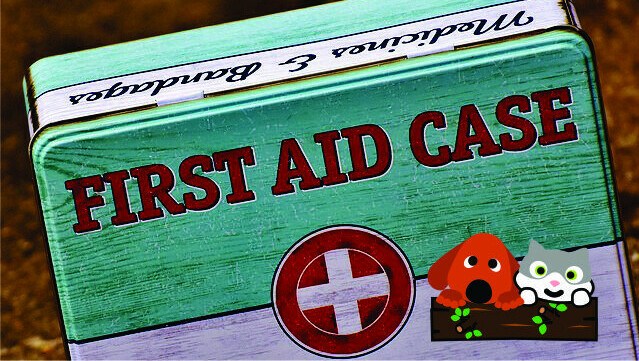The actions to take for common pet injuries and mishaps are found in this article.
Pets can and do get hurt. Knowing how to administer first aid right away can significantly impact their recovery. Learn how to treat cuts, scratches, fractures, broken bones, stings and bites from insects, poisoning, and heatstroke.
Being ready is important, whether your pet has a small cut or a more serious injury. Before you seek medical attention from a professional, you can use this guide to identify the symptoms of various injuries and administer the necessary first aid.
With this understanding, you can respond to an emergency with confidence and speed.

Cuts and Scrapes
Cuts and scrapes are common pet injuries. Understanding how to handle these injuries, cleaning and bandaging them, and seeking appropriate veterinarian care can help prevent infections and ensure quick recovery.
Identifying Minor vs. Major Cuts
Identify the severity of a pet cut, as most minor cuts are superficial involving the top layer of the skin, and stop bleeding on their own. Even though they may cause mild discomfort, pets usually continue their daily activities.
Major cuts are severe, affecting underlying tissues and causing significant pain, limping, or reluctance to move. If visible bone or tissue is present, immediate medical attention is necessary.
Wash the cut area gently with mild soap and water to determine its severity. Significant cuts are over half an inch long, open, or located near joints or on the face. Treat the cut as major if bleeding persists.
Monitor your pet’s behaviour and seek veterinary care if they show abnormal behaviour, shock symptoms (rapid breathing or weak pulse), or signs of infection. Recognize the difference between minor and major cuts to ensure prompt and appropriate care.
Clean and Dress a Wound
Clean and bandage your pet’s wound immediately to prevent infection and promote recovery. Use minimal restraint to keep them still, and if necessary have someone assist or use a muzzle.
Rinse the wound. Rinse wounds with clean, lukewarm water. To remove dirt or debris, use a saline solution of salt and water (1 teaspoon of salt to one cup of water). Avoid hydrogen peroxide or alcohol.
Dry affected area. Pat the wound dry with a clean towel and avoid rubbing. Gently apply pressure with a sterile gauze pad to slow or stop bleeding.
Apply antibiotic ointment. Apply an antibiotic ointment to clean and dry wounds to prevent infection. Ensure the ointment is safe for pets due to potentially harmful ingredients in human products.
Cover the wound. After applying the ointment, cover the wound with a gauze pad, and secure it with a self-adhesive bandage or medical tape. Ensure it fits snugly without being too tight to avoid obstructing blood flow.
Check the wound daily. Every day or whenever it gets filthy or damp, change the bandage. Look for signs of infection, such as pus, swelling, or increasing redness. If the wound doesn’t heal, contact a veterinarian.
When to Seek Veterinary Care for Pet Injuries

Sometimes it is necessary to get pet injuries checked by a veterinarian. Even though small cuts are frequently treatable at home, there are certain signs that you should see a doctor.
Deep wounds. If the wound is longer than half an inch, or you can see muscle or bone, immediate veterinary care is needed. Stitches or other medical actions might be necessary for deep wounds.
Persistent bleeding. This is a serious issue that requires immediate attention, as excessive blood loss can lead to life-threatening shock.
Signs of infection. Identify signs such as increased redness, swelling, warmth, discharge, or pus around the wound, and seek prompt veterinary treatment to prevent the spread of infection.
Behavioral changes. If your pet exhibits signs of severe pain, lethargy, or refusal to eat, seek veterinary care as these may indicate potential complications.
Cautious around sensitive areas. Vets should examine puncture wounds near sensitive areas such as eyes, joints, and genitals or puncture wounds such as bites, as they can cause significant internal damage and infection.
Underlying health conditions. Consult your veterinarian for any wounds in pets with underlying health conditions like diabetes or medications, as these conditions increase the risk of complications in pet injuries.
Fractures and Broken Bones
Fractures and broken bones are serious pet injuries that can cause significant pain and distress.
Learn to identify and treat fractures in pets and treat them with first aid. Safe transportation to the veterinarian ensures prompt and efficient support for their health.
Signs of a Fracture
Identifying your pet’s fracture symptoms is essential for prompt care. This includes noticeable symptoms such as the inability to bear weight or sudden limping, awkward movement, or holding the leg off the ground.
There may be bruising, swelling, malformed or misaligned limbs, pain, decreased mobility, and behavioural changes. These signs indicate tissue injury, internal hemorrhaging, displaced fracture, and potential discomfort in the pet.
You might hear a cracking sound at the time of injury. This indicates a definite break in the bone.
Immediate First Aid Measures
Immediate first aid for pet fractures involves keeping them calm and still, and gently restraining them with a blanket or towel if needed.
Cover area. If the fracture is open with the bone showing through the skin, clean and moisten the area with a cloth to prevent contamination. Never try to reposition the bone by pushing it.
Immobilize the injured limb. Use a splint, such as rolled-up newspapers or sticks, to immobilize an injured limb. Wrap it with a soft cloth and secure it with bandages but not too tightly to cut off circulation.
Avoid food, water or medication. Resist giving your pet any food, water, or medications, as these might interfere with veterinary treatments, especially if surgery is required.
Transport the pet immediately. Once the fracture is stabilized, transport the pet to the vet, using a sturdy carrier. A prompt trip to the vet for serious pet injuries such as fractures or broken bones will aid your pet’s recovery.
Transportation Safety after Pet Injuries
When transporting a pet with a suspected fracture, use a sturdy carrier or firm surface for stability. Avoid pressure on the injured limb and pad it with blankets or towels.
Secure the carrier in the vehicle and drive carefully to minimize discomfort. If the pet is in distress, speak calmly to reassure them.
When you get to the vet, tell the staff about your pet’s condition and possible fracture. They are knowledgeable about pet injuries and will be prepared to provide the required medical attention immediately.
Insect Bites and Stings
While maybe not what you consider pet injuries, insect bites and stings can be a common concern, causing discomfort and, in some cases, more severe reactions. Learn to recognize the signs of insect bites and stings, provide immediate attention, and prevent future incidents.

Recognizing Allergic Reactions
Symptoms of allergic reactions may include swelling around the bite area, hives (red, itchy bumps on the skin), or excessive scratching or licking. In extreme circumstances, your pet can throw up, have trouble breathing, or pass out.
If you notice symptoms like difficulty breathing or collapse, it’s a medical emergency. Seek immediate treatment as allergic reactions can escalate quickly.
Removing Stingers and Treating the Bite
If your pet has been stung by an insect, it’s important to act quickly to ease discomfort and prevent further reaction.
Remove stinger. Use tweezers or the edge of a credit card to find and remove any visible stingers. Be careful not to squeeze the sac since more venom can be released into the wound.
Clean area. Clean the affected area with mild soap and water after removing the stinger to prevent infection. Apply a cold compress or ice pack to reduce swelling and ease pain.
Monitor your pet. As mentioned earlier, look for any signs of allergic reactions. Seek veterinarian assistance if you notice any significant swelling or difficulty breathing.
Administer prescribed medication. For ongoing discomfort, your veterinarian may recommend antihistamines or other medications to manage symptoms.
Preventing Future Insect Bites
Preventing insect bites in pets involves avoiding high insect activity areas, grooming regularly, and keeping fur trimmed to help spot and remove ticks or other insects before they bite
Use pet-safe insect repellents recommended by your doctor, ensuring they are labelled specifically for dogs.
Inspect your pet thoroughly after outdoor activities, especially in warm weather or wooded areas, and remove ticks or insects promptly to reduce the risk of bites and potential infections.
By taking these preventive measures, you can help reduce the chances of your pet experiencing discomfort or allergic reactions from future insect bites.
Poisoning and Toxic Ingestion
Poisoning and toxic ingestion are serious concerns. Pet owners and caregivers should be aware of poisoning symptoms.
Recognizing the signs and taking immediate action could save your pet’s life. Learn how to provide first aid and contact a veterinarian immediately. Being prepared ensures your pet receives the necessary care and recovers safely from an emergency.

Common Household Poisons
Many everyday items in your home can pose a poisoning risk to your pet. Some common household poisons include:
Human Medications: Prescription and over-the-counter drugs have the potential to be toxic to pets, particularly if they are consumed in high amounts.
Household Cleaners: Cleaning supplies like bleach, detergents, and disinfectants have harmful chemicals that pets may ingest or breathe in and cause them to become ill.
Certain Plants: If eaten or swallowed by pets, certain plants, including lilies, azaleas, and philodendrons, can be hazardous.
Food Items: Certain foods should be kept out of pets’ reach since they are harmful to them such as chocolate, grapes, raisins, onions, garlic, and avocados.
Chemical Products: Products like antifreeze, pesticides, and rodenticides are highly toxic to pets and should be securely stored.
Familiarize yourself with potential hazards, store them out of reach, and contact your veterinarian or animal poison control center if your pets have consumed something dangerous.
First Aid Steps for Poisoning
Act quickly if you think your pet may have consumed something poisonous. Immediately remove your pet from the source and securely confine them elsewhere.
Gather the culprit. Collect any packaging or traces of the substance your pet consumed; your vet will need this information to assess the cause.
Contact a vet or poison control. Seek immediate advice from your vet or animal poison control center. They can provide specific instructions based on the toxin and your pet’s symptoms.
Do not induce vomiting. It is advised to seek professional advice before trying home remedies or attempting to induce vomiting, as these actions may potentially cause more harm than good.
Monitor your pet. Look for symptoms such as vomiting, diarrhea, excessive drooling, seizures, or breathing difficulties. Keep the pet calm and comfortable until the vet is available.
Importance of Professional Help
Seeking professional veterinary assistance is imperative in cases of pet poisoning. Veterinarians have the expertise and resources to accurately diagnose the type and severity of poisoning and provide appropriate treatment.
Professional help ensures the timely administration of antidotes or treatments specific to the toxin ingested, which can significantly improve your pet’s chances of recovery.
Veterinary clinics have supportive care measures such as intravenous fluids and medications to manage symptoms and prevent complications.
Do not delay seeking professional help if you suspect your pet has been poisoned, as early intervention can save their life. Contact your veterinarian or an animal poison control center immediately for guidance tailored to your pet’s needs.
Heatstroke

Heatstroke is a serious risk for pets, especially during hot weather or high temperatures for extended periods.
This section aids in recognizing heatstroke symptoms, applying emergency cooling procedures, and avoiding heat-related emergencies. Knowing what to look for and taking immediate action ensures their safety and comfort during hot weather.
Symptoms of Heatstroke in Pets
Symptoms of heatstroke in your pet require immediate action. Watch for signs such as excessive drooling and panting, breathing difficulties, a fast heartbeat, and weakness or tiredness.
Other symptoms include a collapse, diarrhea, or vomiting.
Older pets, or those with thick coats, or short noses (such as pugs or bulldogs) are more prone to heatstroke.
Move your pet to a cooler spot and start cooling them down if you think they suffer from heatstroke.
Emergency Cooling Techniques
Cool your pet down safely and quickly if they show signs of heatstroke. Immediately take your pet inside where it is air-conditioned or shaded.
Use wet towels, a tub of cool water, or a hose with cool, not chilly, water to hydrate their fur and skin. Avoid ice packs or ice-cold water, as they can narrow blood vessels.
Use a fan to cool your pet by promoting evaporation and reducing their body temperature to 103°F (39.4°C).
Offer small amounts of cool water, but don’t force them. Contact your veterinarian for further advice and care. Heatstroke can lead to serious complications if not treated promptly.
Preventing Heatstroke
Preventing heatstroke in pets involves preventative steps to keep them cool and comfortable, especially during hot weather:
Provide access to shade. Ensure your pet has a shady spot to rest outdoors, away from direct sunlight.
Provide fresh water: Always provide cool fresh water for your pet. Think about setting up several water bowls in various places.
Avoid strenuous exercise. Reduce outdoor activities during hot hours and opt for early morning or late evening walks when the weather is cooler.
Never leave pets in cars. Cars can quickly become dangerously hot, even with cracked windows. It’s advisable to leave pets at home if they can’t be brought inside.
Cooling aids: Use cooling mats, vests, or bandanas to help regulate your pet’s body temperature during hot weather.
Conclusion
Awareness of common pet injuries and how to provide immediate first aid can make a major difference in your pet’s health and recovery.
When managing injuries such as wounds, fractures, bug bites, poisoning episodes, or heatstroke, provide immediate attention and appropriate treatment.
You can be more prepared to protect your pet’s well-being during these potential emergencies by recognizing the symptoms and taking precautions.
Remember to consult your veterinarian for any serious injuries or concerns. Proactive steps and timely action can help ensure the best possible care for your pets.

We love to travel. For our trip to Mexico, we were able to save money by house sitting, which was something completely new to us. If this is something that interests you, then check out TrustedHousesitters or HouseSitMexico (be sure and use Code thetr6210d47b7cc90 for discount). We hope you visit often.